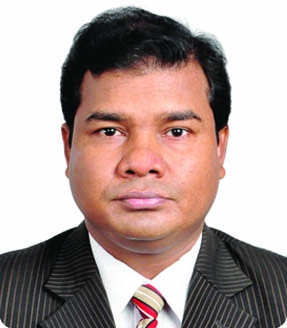60 lakh families to be benefited
from ‘amar bari amar khamar’

The government will bring at least 60 lakh poor families under the 'Amar Bari Amar Khamar' project. Under the scheme, it will form one lakh Village Development Samitis selecting the beneficiaries from among the rural marginal poor. The samiti members will be given professional trainings in farming and five members from each samity will be provided with small credit.
"The fund of the Village Development Samiti will be invested in small farming and phase by phase each and every home in the villages will be turned into a productive farm house", said Director of the Project, Md Akber Hossain. He said the project also aims at ensuring sustainable development through women empowerment and poverty alleviation.
Mohammad Nabab Ali, a physically challenged villager of Nilphamari district, is now an independent and confident as ‘Amar Bari Amar Khamar’ (My House My Firm) project has changed his life and brought smile back on his family members’ faces as well. Nabab Ali was an employee of Palli Bidyut Samity. He along with his family members live at Ward no 7 under Putimari Union in Kishoroganj Upazila of the district. He lost one of his legs in an accident and after that he had plunged into financial crisis.
Encouraged by neighbours, he took Tk 10,000 from the Samiti of 'Amar Bari Amar Khamar' project. Later, he bought a cow with calf at Tk 20,000 and has taken up cattle farming at his house as both cattle and milk have a huge demand in the local market, making him self-reliant. “After I met with the tragic accident at my work place and lost one of my legs, I used to often find myself abandoned and alone.
And my family members were also hit hard by the financial crisis as I couldn’t do any work. Frustration and uncertainty gripped my family. My life was a tale of sorrow. But I have left behind that unhappy chapter. Now, I’m fine and solvent as I have cattle and milk. I sell milk and cattle and earn money,” he said in a choked voice.
Like Nabab, many other marginal people across the country are now becoming self-reliant through small savings instead of loan and leading a comfortable life. According to LGRED Ministry sources, a total of 60,615 associations (samiti will be formed across the country under the project within 2020 and the members of those associations will be around three crore.
The project name was Ekti Bari Ekti Khamar (One House One Firm. Later, the programme was renamed as “Amar Bari Amar Khamar. The government has taken up the project in order to make rural people economically solvent. An official of LGRED Ministry said all Deputy Commissioners have already been asked to give more attention to the implementation of ‘Amar Bari Amar Khamar’ project.
The number of 'samiti' under the project is now 98,920 and member-families are 43 lakh 75,969. The samiti has its own deposit of Tk 1600 crore 37, 50,000 having a total fund of Tk 5455 crore 90, 9000. The samitis have so far disbursed credit of Tk 6049 crore 69, 90,000 and recovery from credit amount is Tk 2750 crore 94 lakh 85,000.
Under the project, a bank named 'Palli Sanchya Bank has been established which has disbursed credit of Tk 5402, 42, 29,956 till March 31 this year and recovered Tk. 3396, 65, 09,847. The bank also has disbursed SME loan of 134.16 crore among 26796 clients and recovered Tk 28.26 crore. Akbar Hossain said the micro saving model of the Prime Minister could bring a radical change in the country’s poverty scenario through activities like assisting in the formation of capital through collection of small savings of underprivileged rural people, enhancing competency through training, make the house a center of productive activity and increase investment at the marginal level in the agricultural sector.
He stressed on ensuring empowerment of women by enhancing efficiency and capacity of entrepreneurs through training to implement the income generating programme, creating a group of human resources, ensuring integrated rural development, and involvement of the disadvantaged population in poverty alleviation activities through a combination of information technology and ensuring maximum utilization of natural and human resources.


